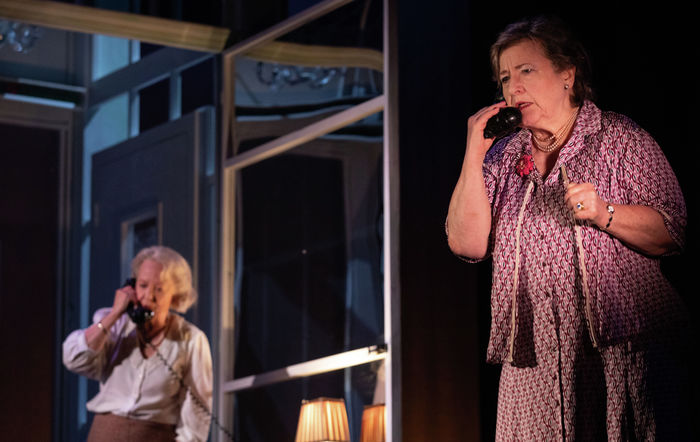Indecent: a visually stunning sensation
Performances from a stunning ensemble of actors and musicians elevate a nuanced look at anti-semitism, homophobia, and the meaning of art

Paula Vogel’s Indecent is no small feat to pull off. It tells the true story of a Jewish playwright, Sholem Asch, as he shepherds his play The God of Vengeance from its creation in 1906 Warsaw, across Europe on tour, onto Broadway in 1923, where the cast is arrested on obscenity charges for the portrayal of lesbians, and then to the future as it traverses the waves of cultural memory. Spanning 40 years and both sides of the Atlantic, Indecent explores rich themes such as anti-semitism, homophobia, and the role of art. This makes it a huge undertaking and an ambitious choice for a student production. Elizabeth Laurence’s production of this deeply complex play rises to its challenges and is nothing short of phenomenal.
Perhaps Laurence’s greatest feat is the handling of the theme of instability in a story about the Jewish migrant experience. Seven members of the cast dance between thirty roles with only simple costume changes and a switch of accent to aid them. Although running the risk of confusion, the production manages the total continuity of Vogel’s characters whilst passing the roles between the ensemble of phenomenally talented actors. The ephemerality of any one actor’s hold on their character sensitively conveys how migrants can feel required to make themselves palatable to new audiences.
“One of the most captivating optical experiences I’ve witnessed in the ADC”
Amongst all the instability, the only two constants are the character of Lemmel, the stage manager beautifully portrayed by Dominika Wiatrowska, and the Klezmer music produced by a four piece band. The music touchingly reflects the importance of cultural identity as a point of stability in the otherwise diasporic migrant experience, providing stability in the ever-shifting world of the play.
Laurences’ direction is beautifully complimented by Matthew Wadey’s Brechtian set and Edward De’Ath’s exceptional lighting. A series of imposing panels stretch high up the ADC stage and are starkly juxtaposed by the remainder of the set: seven chairs. De’Ath’s design makes glorious use of the side lighting from the wings, to create a lighting state that plays with shadow as much as it does with illumination. Combined with Katie Wrench’s stripped back costume design, and Dominika Wiatrowska’s sharp choreography, the production is a visual masterpiece.
All these elements fuse together to create one of the most captivating optical experiences I’ve witnessed in the ADC, particularly in the play’s opening sequence. Without giving too much away — this is a moment to be experienced without spoilers — De’Ath’s shadows, a strikingly effective use of sand, and the dancing of the Horah instantly capture an audience, their seats melting away under them. These three transportive minutes alone are worth the price of admission. However, if you were to leave right after, you’d be missing out on the incredible ensemble work.
By utilizing a truly cohesive ensemble, rather than spotlighting the characters individually, a celebration of Jewish identity was brought to the fore. The audience’s attention was focused on the art being produced, rather than the artists themselves. This worked to reflect a key theme of Vogel’s play: the resistance to the commercialisation of the arts, arguing instead that the importance of art lies in its contribution to the community it speaks to. The ADC stage is frequently treated to shows with incredible individual talent; it is much rarer to be home to such a vocally and physically talented ensemble.
In an attempt to handle the multitude of temporal and geographical settings of the play, the production relies heavily on projected surtitles. For the most part these are highly effective, however, they suffer from two issues. The first and most substantial problem is that their frequency occasionally encroaches on the otherwise slick production, feeling slightly like a lecturer rushing through a slideshow. The second was that because of how the lighting and set were designed, at points, these surtitles are difficult to read. However, this flaw is more than compensated for by the rest of the technical production.
Indecent is a play that sparks wider reflection. It challenges the whitewashed narrative of anti-semitism that many non-Jewish students are sold in our education system and asks its audience to remember the deep roots of this prejudice within Anglo-American society far before the atrocities of National Socialism. This issue is not one that has always been treated with the appropriate sensitivity in Cambridge theatre, but Indecent handles it with grace and integrity.
 News / Eight Cambridge researchers awarded €17m in ERC research grants27 December 2025
News / Eight Cambridge researchers awarded €17m in ERC research grants27 December 2025 News / Clare Hall spent over £500k opposing busway 24 December 2025
News / Clare Hall spent over £500k opposing busway 24 December 2025 Comment / League tables do more harm than good26 December 2025
Comment / League tables do more harm than good26 December 2025 Comment / The ‘class’ of Cambridge24 December 2025
Comment / The ‘class’ of Cambridge24 December 2025 News / Caius mourns its tree-mendous loss23 December 2025
News / Caius mourns its tree-mendous loss23 December 2025









